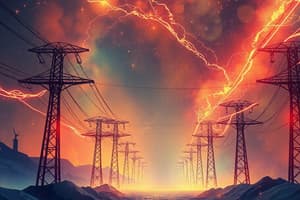Podcast
Questions and Answers
What is the primary reason for the development of electrical engineering?
What is the primary reason for the development of electrical engineering?
- To enable humans to extend their working hours despite natural light and weather conditions (correct)
- To harness thermal radiation for illumination
- To facilitate the use of incandescent lighting
- To explore the application of electricity in various domains
What prevents the tungsten filament in incandescent lamps from catching fire?
What prevents the tungsten filament in incandescent lamps from catching fire?
- A vacuum-sealed bulb
- The high melting point of tungsten
- A sealed bulb filled with a mixture of nitrogen and an inert gas (correct)
- An oxygen-free environment
What is the approximate temperature to which the tungsten filament in incandescent bulbs heats?
What is the approximate temperature to which the tungsten filament in incandescent bulbs heats?
- 6,000°F (3,315°C)
- 3,000°F (1,650°C)
- 5,000°F (2,760°C)
- 4,532°F (2,500°C) (correct)
What percentage of the radiation emitted from the incandescent filament is visible light?
What percentage of the radiation emitted from the incandescent filament is visible light?
What is the purpose of using an inert gas such as argon in incandescent lamps?
What is the purpose of using an inert gas such as argon in incandescent lamps?
What is the primary reason for the development of electrical engineering?
What is the primary reason for the development of electrical engineering?
What prevents the tungsten filament in incandescent lamps from catching fire?
What prevents the tungsten filament in incandescent lamps from catching fire?
What is the approximate temperature to which the tungsten filament in incandescent bulbs heats?
What is the approximate temperature to which the tungsten filament in incandescent bulbs heats?
What percentage of the radiation emitted from the incandescent filament is visible light?
What percentage of the radiation emitted from the incandescent filament is visible light?
What is incandescent lighting primarily a result of?
What is incandescent lighting primarily a result of?
Flashcards are hidden until you start studying





